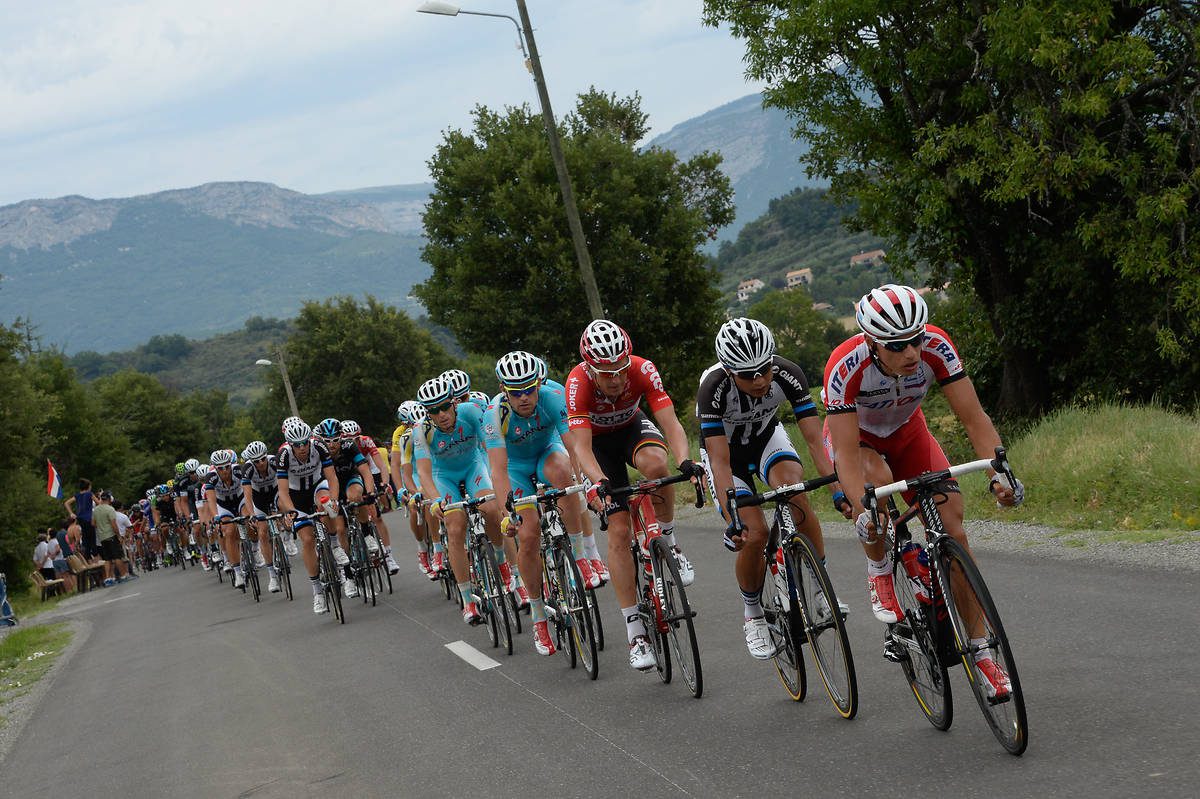Riding in an echelon
For cyclists, riding in an echelon formation well is an essential skill. Being able to manage crosswind situations saves energy and strength and can be an advantage in a race. The same principles and techniques work for recreational cycling, too. A group running a proper echelon formation will move quickly and efficiently without struggling in the wind.


A peloton split into echelons is one of the most compelling images in cycling. Each group is staggered across the road, racing forward with its riders moving in a fluid sideways rotation. The force of the wind has blown across the field leaving the protection of the draft to the side and slightly behind the rider ahead. With space limited on the road for such lateral sheltering, racers not in the front selection are forced into the proverbial gutter, fighting a vain battle in the wind. It is a futile predicament that forces the formation of another rotation behind. Often the race will split into several echelons that, from the sky, look like several diagonal lines chasing each other along the road.
For cyclists, riding in an echelon formation well is an essential skill. Being able to manage crosswind situations saves energy and strength and can be an advantage in a race. The same principles and techniques work for recreational cycling, too. A group running a proper echelon formation will move quickly and efficiently without struggling in the wind.
An echelon operates much like a traditional paceline, with riders swapping pulls at the front then filtering back in the slipstream of those ahead. However, to accommodate a crosswind, the rotation will file back from the leading rider diagonally; swinging to the left if the wind is coming from the right and vice-versa as each rider maximizes his draft.
It’s very important to hold the formation, moving spot to spot as the rotation demands. Riders must pay careful attention to the draft of the person they’re following. The patch of calm air behind a rider is constantly shifting based on position and the direction of the wind. The aim is to remain in that draft as accurately as possible. It’s important to keep pedalling and maintain a fluid cadence. It’s easy in a heavy wind to get stuck pushing big gears, but this gearing requires extra energy and makes it difficult to match the accelerations and movements that come with riding in a group.
As the leading rider drops to the back from his turn at the front and the next takes his place, each rider shifts positions forward in the pack. It’s crucial to maintain an even, steady pace while in the lead because rapid accelerations disrupt the flow of the whole group. Time spent pulling at the front should be quick and consistent. The point is to use the group as an advantage by sharing the workload. Longer, harder pulls are inefficient and defeat the purpose.
After your turn at the front is done, drift backward, but be ready to grab the last wheel – especially if it’s a race situation. Once the last rider in the echelon passes, accelerate to match the speed of the group and move into the draft of that final rider. Timing here is crucial. Missing the wheel or leaving a gap disrupts the circulation and means an unnecessary effort to get back into the group. It also opens the door for another rider who has just finished their pull to jump in and grab that spot. Done properly, however, the transition and rotation is seamless and smooth. From here, you move forward through the group until it’s your time at the front again.
There is a rhythm and joy to riding in a properly executed echelon. It’s a skill that every cyclist who rides in groups should learn. Over time and with plenty of practice, it will become second nature. To master the skill, ride with more accomplished riders and form echelons whenever conditions dictate. Whether you’re in a race or on a Sunday morning group ride, cycling is all about moving quickly and efficiently and knowing how to deal with crosswinds will make you a better rider.
